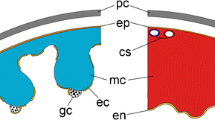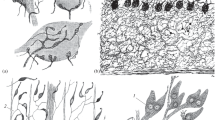Summary
The fine structure of junctional specializations on the segmental septa in the median and lateral giant fibers of the earthworm (Eisenia foetida) was examined. Eight morphologically different septal domains were identified; a gap junction, a junction with hemispherical hollow structures, a chemical synapse-like junction, intermediate type and punctum adherens type junctions, a junction with adjoining vesicular layers, an area flanked by flattened membranous sacs, a non specialized area, and an area consisting of widely separated membranes with interposed glial processes. The area of each domain was measured by a cytometrical technique using quasi-serial sections. The gap junction occupied 3% and 0.2% of the septal area of the median and lateral giant fibers, respectively. Junctions with hemisperical hollow structures, characteristic of the earthworm giant fibers, occupied 2.5% and 13.9% of the median and lateral giant fibers, respectively. Various membrane domains except the gap junction, the junction with hemispherical hollow structures, and the chemical synapse-like junction accounted for similar proportional areas in both median and lateral giant fibers.
The functional implications of these junctional specializations, especially the gap junction, are discussed.
Similar content being viewed by others
References
Brink PR, Barr L (1977) The resistance of the septum of the median giant axon of the earthworm. J Gen Physiol 69:517–536
Brink PR, Dewey MM (1978) Nexal membrane permeability to anions. J Gen Physiol 72:67–86
Brink PR, Dewey MM (1980) Evidence for fixed charge in the nexus. Nature 285:101–102
Brink PR, Dewey MM, Colflesh DE, Kensler RW (1981) Polymorphic nexuses in the earthworm Lumbricus terrestris. J Ultrastruct Res 77:233–240
Bullock TH (1945) Functional organization of the giant fiber system of Lumbricus. 1 Neurophysiol 8:55–71
Coggeshall RE (1965) A fine structural analysis of the ventral nerve cord and associated sheath of Lumbricus terrestris. L. J Comp Neurol 125:393–438
Dewey MM, Barr L (1964) A study of the structure and distribution of the nexus. J Cell Biol 23:553–585
Eccles JC, Granit R, Young JZ (1933) Impulses in the giant fibers of earthworms. J Physiol (London) 77:23–24
Goodenough DA (1975) The structure and permeability of isolated hepatocyte gap junctions. Cold Spring Harbor Symp 40:37–413
Hama K (1959) Some observations on the fine structure of the giant nerve fibers of the earthworm, Eisenia foetida. J Biophys Biochem Cytol 6:61–66
Hama K, Saito K (1977) Gap junctions between the supporting cells in some acoustico-vestibular receptors. J Neurocytol 6:1–12
Hand AR, Gobel S (1972) The structural organization of the septate and gap junctions of Hydra. J Cell Biol 52:397–408
Kao CY, Grundfest H (1957) Postsynaptic electrogenesis in septate giant axons. I. Earthworm median giant axon. J Neurophysiol 20:553–573
Kensler RW, Brink PR, Dewey MM (1979) The septum of the lateral axon of the earthworm: a thin section and freeze-fracture study. J Neurocytol 8:565–590
Kosaka T (1980) Ruffed cell: A new type of neuron with a distinctive initial unmyelinated portion of the axon in the olfactory bulb of the gold fish (Carassius auratus). II. Fine structure of the ruffed cell. J Comp Neurol 193:119–145
Kosaka T, Hama K (1982) Structure of the mitral cell in the olfactory bulb of the gold fish (Carassius auratus). J Comp Neurol 212:365–384
Larsen WJ (1983) Structural diversity of gap junctions: A review. Tissue Cell 9:373–394
Matter L (1973) A morphometric study on the nexus of rat cardiac muscle. J Cell Biol 56:690–696
McNutt NS, Weinstein RS (1970) The ultrastructure of the nexus. A correlated thin-section and freeze-cleave study. J Cell Biol 47:666–688
McNutt NS, Weinstein RS (1973) Membrane ultrastructure at mammalian intercellular junctions. Prog Biophys Mol Biol 26:47–101
Neyton J, Trautmann A (1985) Single-channel currents of an intercellular junction. Nature 317:331–335
Oesterle D, Barth FG (1973) Zur Feinstruktur einer elektrischen Synapse. Die Septen der dorsalen Riesenfasern von Regenwürmern (Lumbricus ferrestris, Eisenia foetida). Z Zellforsch 136:139–152
Page E, Manjunath CK (1985) Biochemistry and structure of cardiac gap junctions: Recent observations. In: Bennett MVL, Spray DC (eds) Gap junctions. Cold Spring Harbor Laboratory, pp 49–56
Peracchia C (1973) Low resistance junctions in crayfish. II. Structural details and further evidence for intercellular channels by freeze-fracture and negative staining. J Cell Biol 57:66–76
Rushton WAH (1945) Action potentials from the isolated nerve cord of the earthworm. Proc R Soc London [Biol] 132:423–437
Simpson I, Rose B, and Loewenstein WR (1977) Size limit of molecules permeating the junctional membrane channels. Science 195:294–296
Sotelo C, Korn H (1978) Morphological correlates of electrical and other interactions through low-resistance pathways between neurons of the vertebrate central nervous system. Int Rev Cytol 55:67–108
Spray DC, Saez JC, Brosius D, Bennett MVL, and Hertzberg EL (1986) Isolated liver gap junctions: Gating of transjunctional current is similar to that in intact pairs of rat hepatocytes. Proc Natl Acad Sci USA 83:5494–5497
Staehelin LA (1972) Three types of gap junctions interconnecting intestinal epithelial cells visualized by freeze-etching. Proc Natl Acad Sci USA 69:1318–1321
Staehelin LA (1974) Structure and function of intercellular junctions. Int Rev Cytol 39:191–283
Stough HB (1926) Giant nerve fibers of the earthworm. J Comp Neurol 40:409–463
Stough HB (1930) Polarization of the giant nerve fibers of the earthworm. J Comp Neurol 50:217–229
Wood RL, Hageman GS (1982) The fine structure of cellular junctions in a marine Bryzoan: Gap junctions. J Ultrastruct Res 79:174–188
Yamamoto M, Kataoka K (1985) Large particles associated with gap junctions of pancreatic exocrine cells during embryonic and neonatal development. Anat Embryol 171:305–310
Author information
Authors and Affiliations
Rights and permissions
About this article
Cite this article
Hama, K. Fine-structural and morphometrical studies on the segmental septa of the giant fibers in the earthworm, Eisenia foetida . Cell Tissue Res. 249, 565–575 (1987). https://doi.org/10.1007/BF00217328
Accepted:
Issue Date:
DOI: https://doi.org/10.1007/BF00217328




